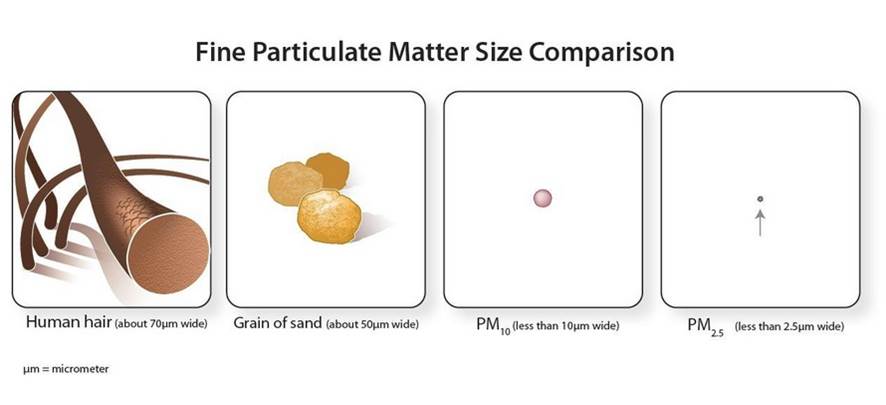Colonies of fungi and bacteria shed particulates into the indoor air ranging from nanoparticles to 9 mm or larger. For convenience of this discussion, the particulates will be divided into large and small particle fractions.
The larger particles are >2 mm consisting of spores and hyphal fragments. They contain mycotoxins, antigenic material, enzymes, haemolysins and other potentially toxic metabolites with adverse effects on the lungs of mice and rats. Hyphal fragments of S. chartarum and other genera of molds probably caused pulmonary bleeding in infants (Dearborn et al, 2002; Etzel et al, 1998; Flappan et al, 1999; Novotny and Dixit, 2000). S. chartarum was isolated from the lung of a child with pulmonary bleeding and haemosiderosis (Elidemer et al, 1999).
Spores, hyphal fragments and extracts from several genera of molds cause inflammatory changes in the lungs and nasal passages (Brieland et al, 2001; Rand et al, 2002, 2003, 2005; Schwab and Straus, 2004; Yike et al, 2005, 2007).
The shedding of fine particles (<2 mm) from fungal and bacterial growth results from human activity (e.g., radio, TV, talking, walking, etc.) which creates vibrations at frequencies from 1 to 20 Hz and air movement (Gorny, 2004; Gorny et al, 2002). The vibrations along with air velocity release spores,
hyphal fragments and fine particulates. The fine particles are up to 320 times more numerous than the large particulates, depending upon mold species and velocity of air.
Furthermore, the fine particulates also contain biocontaminants (mycotoxins, endotoxins, antigens, haemolysin, etc.) produced by fungi and bacteria (Brasel, et al, 2004, 2005a,b; Van Emon et al, 2003) and are immunogenic (Gorny, 2004).
The mean diameter, size and density of particulates, particularly nanoparticles, determine the deposition in the nasal cavity and levels of the tracheobronchial tree. Particles <5 mm are deposited in alveolar spaces (Oberdorster et al, 2004; Peters et al, 2006).
Nanoparticles mainly deposit in alveoli and transfer into the systemic circulation and distribute to other organs, including the brain (Calderon-Garciduenas et al, 2004, 2008a,b,c; Elder and Oberdorster, 2006; Nemmar et al, 2001; Peters et al, 2006). Transfer into the brain via the olfactory nerve is probable with mycotoxins as well as cadmium, other chemicals, drugs and
viruses (Calderon-Garciduenas et al, 2004, 2008a,b,c; Eriksson et al, 1999; Islam et al, 2006, 2007; Larsson and Tjalve, 2000; Peters et al, 2006).
As an example, children and young adults exposed to severe air pollution in Mexico City have deposits of particles in the olfactory mucosa with transport along the olfactory tract bulb that show upregulation of markers of inflammation in the frontal cortex, hippocampus, cerebellum and alteration of the blood–brain barrier (Calderon-Garciduenas et al, 2004, 2008a,b,c).
In addition, the translocation of ultrafine particles to the olfactory bulbs and extra-pulmonary organs was observed in rats (Oberdorster et al, 2004) and humans (Peters et al, 2006) demonstrating that fine particles target the brain and other organs, e.g., blood vessels, cardiovascular system and kidneys.
Evidence for endothelial inflammation and damage in children was characterized by increased TNF-a, prostaglandin E2(PGE2), C-reactive protein and increased endotholein-1 and down-regulation of soluble adhesion molecules (Calderon-Garciduenas et al, 2008c).
Finally, air pollution leads to brain inflammation resembling
Alzheimer-like pathology as well as neurocognitive deficits in young adults and children (Calderon-Garciduenas et al, 2004, 2008a). These authors also demonstrated fine particles within RBCs (red blood cells) adjacent to capillary endotheliumin the brain.
In conclusion, exposure to fine particles present in damp indoor spaces (Gorny, 2004) that have been proven to contain
trichothecenes (Brasel et al, 2005a,b; Gottschalk et al, 2008) and other toxic metabolites (Johanning et al, 2002a,b) must be considered as probable sources of human neurocognitive abnormalities.



